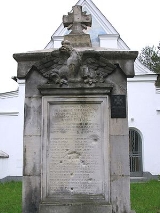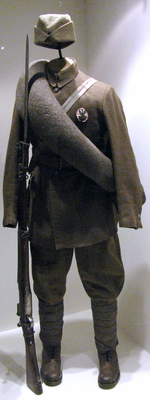
Battle of Ossów
Encyclopedia


Battle of Warsaw (1920)
The Battle of Warsaw sometimes referred to as the Miracle at the Vistula, was the decisive battle of the Polish–Soviet War. That war began soon after the end of World War I in 1918 and lasted until the Treaty of Riga resulted in the end of the hostilities between Poland and Russia in 1921.The...
during the Polish-Bolshevist War (February 1919 - March 1921). During the day Russian units managed to capture the strategically important village of Ossów
Ossów
Ossów is a village in the administrative district of Gmina Wołomin, within Wołomin County, Masovian Voivodeship, in east-central Poland. It lies approximately south of Wołomin and north-east of Warsaw.-References:...
, but were repelled in the evening by a Polish counter-attack. The battle was one of the first skirmishes won by the Poles since the beginning of the Soviet offensive in late spring.
Battleground
The battle was fought as the Red ArmyRed Army
The Workers' and Peasants' Red Army started out as the Soviet Union's revolutionary communist combat groups during the Russian Civil War of 1918-1922. It grew into the national army of the Soviet Union. By the 1930s the Red Army was among the largest armies in history.The "Red Army" name refers to...
forces commanded by Mikhail Tukhachevsky
Mikhail Tukhachevsky
Mikhail Nikolayevich Tukhachevsky was a Marshal of the Soviet Union, commander in chief of the Red Army , and one of the most prominent victims of Joseph Stalin's Great Purge.-Early life:...
approached the Polish
Poland
Poland , officially the Republic of Poland , is a country in Central Europe bordered by Germany to the west; the Czech Republic and Slovakia to the south; Ukraine, Belarus and Lithuania to the east; and the Baltic Sea and Kaliningrad Oblast, a Russian exclave, to the north...
capital of Warsaw
Warsaw
Warsaw is the capital and largest city of Poland. It is located on the Vistula River, roughly from the Baltic Sea and from the Carpathian Mountains. Its population in 2010 was estimated at 1,716,855 residents with a greater metropolitan area of 2,631,902 residents, making Warsaw the 10th most...
and nearby Modlin Fortress
Modlin Fortress
Modlin Fortress is one of the biggest 19th century fortresses in Poland. It is located the town of Nowy Dwór Mazowiecki in district Modlin on the Narew river, some 50 kilometres north of Warsaw...
. The village of Ossów lay on a strategically important road leading from Warsaw towards Stanisławów and was considered crucial for both sides of the conflict. However, the retreat from the Bug River
Bug River
The Bug River is a left tributary of the Narew river flows from central Ukraine to the west, passing along the Ukraine-Polish and Polish-Belarusian border and into Poland, where it empties into the Narew river near Serock. The part between the lake and the Vistula River is sometimes referred to as...
line left Polish forces in disarray and there were barely any forces available to defend the area of Ossów.
In the Polish plans the Leśniakowizna
Lesniakowizna
Leśniakowizna is a village in the administrative district of Gmina Wołomin, within Wołomin County, Masovian Voivodeship, in east-central Poland....
-Ossów road was to be used as a means of retreat from the first line of defences towards Warsaw and the second line of trenches, located slightly to the west of Ossów itself.
Forces
By mid-August the area was manned by the 18th Infantry Division18th Infantry Division (Poland)
The 18th Infantry Division was a unit of the Polish Army during the interbellum period, which took part in the Polish September Campaign...
, a battle-hardened and well-equipped, yet tarnished and overstretched unit. The village itself was defended by the remnants of the 33rd and 36th Infantry Regiments of the Polish Army. The earlier unit was considered a high-morale regiment due to a large number of conscripts from the region of Mazovia
Mazovia
Mazovia or Masovia is a geographical, historical and cultural region in east-central Poland. It is also a voivodeship in Poland.Its historic capital is Płock, which was the medieval residence of first Dukes of Masovia...
. Also the latter unit was considered elite as it was an all-volunteer unit drafted from among the students of various Warsaw-based universities (hence the unit was nicknamed the Academic Legion). Immediately before the battle the two regiments were reinforced with newly created 221st and 236th Infantry Regiments of the Volunteer Army: both understrength and under-equipped, the latter unit composed in large part of volunteers from Warsaw's gymnasiums
Gymnasium (school)
A gymnasium is a type of school providing secondary education in some parts of Europe, comparable to English grammar schools or sixth form colleges and U.S. college preparatory high schools. The word γυμνάσιον was used in Ancient Greece, meaning a locality for both physical and intellectual...
.
On the Russian side of the front were elements of the 79th Rifle Brigade and 2nd Rifle Division, commanded by Grigori Khakhanyan. In total, the Bolshevist commander had three regiments at his disposal (235th, 366th and 16th), with a cavalry corps of Gayk Bzhishkyan
Gayk Bzhishkyan
Hayk Bzhishkyan |Russian]]: Гайк Бжишкян, also known as Guy Dmitrievich Guy, Gai Dmitrievich Gai , Gaya Gai , or Bzhishkyan, –December 11, 1937), was a Soviet military commander of the Russian Civil War and Polish-Soviet War.-Biography:Hayk was an ethnic Armenian born in Tabriz, Iran to a family...
in reserve.

